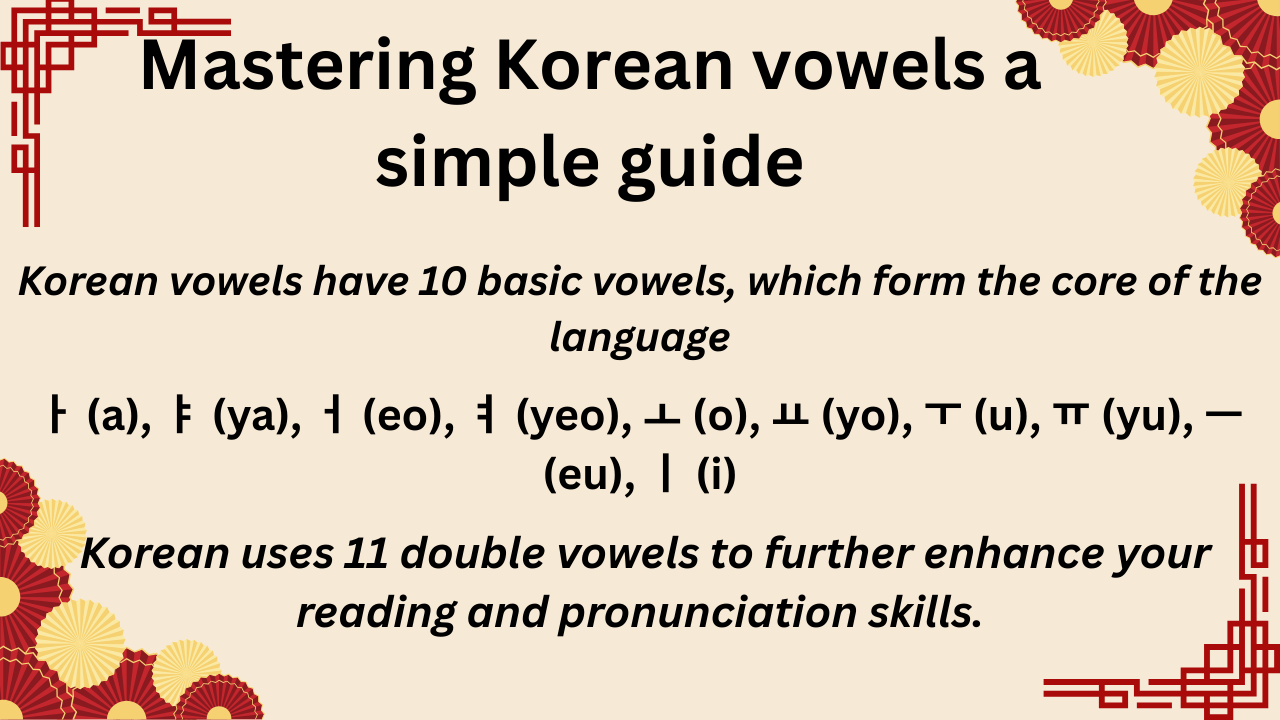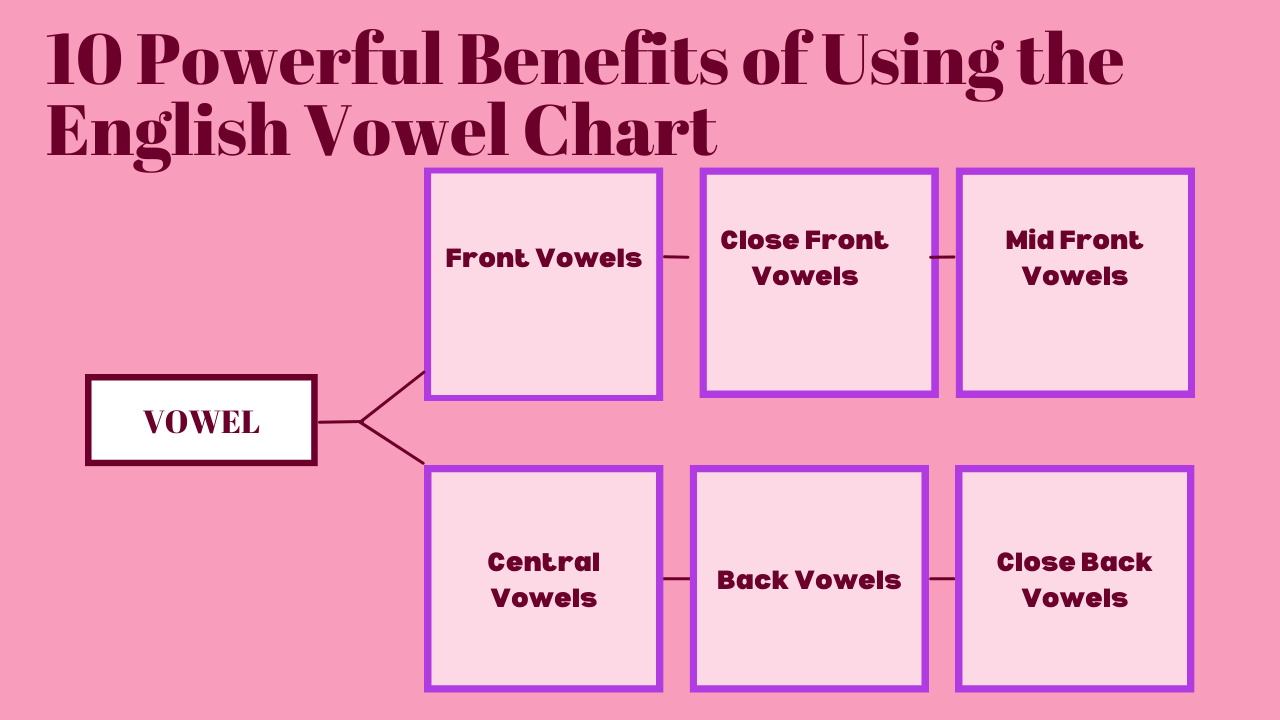Studying Korean is the key to an amazing language and culture, but beginning with basics is important. Korean vowels, the foundation of the Hangul alphabet, are an essential starting point for anyone interested in reading, writing, or speaking Korean. This manual deconstructs Korean vowels into simple-to-grasp sections, from basic vowels to double vowels, pronunciation tips, and syllable formation. By the time you finish reading this post, you’ll be prepared to confidently begin learning the Korean language.
Korean Basic Vowels
- Korean vowels have 10 basic vowels, which form the core of the language. These vowels are either used alone or with consonants to create syllables.
- Below is a list of the 10 basic vowels in Hangul (the Korean alphabet):
- ㅏ (a)
- ㅑ (ya)
- ㅓ (eo)
- ㅕ (yeo)
- ㅗ (o)
- ㅛ (yo)
- ㅜ (u)
- ㅠ (you)
- ㅡ (EU)
- ㅣ (i)
- Each of these vowels has a distinct sound and trait. The beauty of Hangul is that it is systematically designed, which renders it a simple language to learn, even for amateurs.
Quick Tips for Recognizing Basic Vowels
- Vertical vowels such as ㅏ and ㅑ are written from top to bottom.
- Horizontal vowels such as ㅗ and ㅜ are written left to right.
- ㅣ is a horizontal line and serves as the foundation of most other vowels.
Korean Double Vowels
- Double vowels, or diphthongs, are produced by putting two basic vowels together to make one sound. Korean uses 11 double vowels to further enhance your reading and pronunciation skills.
- The following are the 11 double vowels in Hangul:
- ㅐ (ae)
- ㅒ (yae)
- ㅔ (e)
- ㅖ (ye)
- ㅘ (wa)
- ㅙ (wae)
- ㅚ (oe)
- ㅝ (wo)
- ㅞ (we)
- ㅟ (wi)
- ㅢ (ui)
- Double vowels are important because they allow more sophisticated pronunciations and provide more flexibility in word formation.
Common Questions About Double Vowels
- Do double vowels blend sounds? They do. They form blended sounds by combining two vowels. For example, “ㅘ” blends ㅗ (o) and ㅏ (a) to form “wa.”
- Are double vowels more difficult to learn? Not at all. Mastering fundamental vowels first makes double vowels significantly easier to learn.
How to Pronounce Korean Vowels
Proper pronunciation is crucial for effective communication in Korean. Here’s a breakdown to ensure you pronounce Korean vowels like a native speaker.
Pronouncing Basic Vowels
Each vowel has a distinct sound. Keep these tips in mind when practicing basic vowels:
- ㅏ (a) as in “father”
- ㆓ (eo) as in “bun” with a hint of “uh
- ㅗ (o) which means “go.”
- ㅜ (u) as in “blue”
- ㅡ (EU) has no English counterpart but is pronounced by maintaining the lips flat and producing an “uh” sound
Pronouncing Double Vowels
Double vowels need extra care in blending the sounds together. For instance,
- ㅘ (wa) sounds like “wow” without the final “w
- ㅢ (UI) is difficult and rhymes with “ee” that comes quickly after an “uh.” Pro Tip: Practice listening and repeating vowel sounds with a language-learning app or audio materials. Websites such as Italki or Naver Dictionary have great Korean pronunciation tutorials.
How to Form Syllables with Korean Vowels
Korean syllables are formed through the combination of consonants and vowels and occasionally have a final consonant referred to as a “batch.” Each syllable should have at least one vowel. The Frame of a Korean Syllable
A Hangul syllable block may be one of the following:
- Consonant + Vowel (CV), for example, 가 (ga)
- Consonant + Vowel + Consonant (CVC), for example, 강 (gang)
Examples of Syllable Formation
With simple vowels:
ㅏ + ㄱ = 가 (ga)
ㅗ + ㄴ = 논 (non)
With double vowels:
ㅘ + ㄴ = 완 (wan)
ㅙ + ㄹ = 왜 (wae)
The brilliance of Hangul is that it uses a logical system. After learning the consonants and vowels, it is natural to construct syllables.
Practicing Syllable Formation
- Randomly write down consonants and vowels.
- Join them together in syllables.
- Practice reading those syllables out loud.
- Fun Fact: Hangul was invented in the 15th century by King Sejong and his academics to popularize reading and writing. The rational structure of Hangul letters follows their sounds, thus one of the world’s most scientific writings.
Unlock Your Korean Language Journey
Gaining command of Korean vowels is the initial step towards unlocking the realm of Hangul. Learning fundamental vowels, practicing double vowels, perfecting your pronunciation, and forming syllables serves to establish a sound basis upon which to build even more learning.
Looking to elevate your Korean language proficiency? Check out resources such as Talk to Me in Korean or try online language courses to refine your skills.
Practice today, and before long, you will be confidently reading and writing Korean. Good luck!
FAQs
Q1: How many vowels does the Korean alphabet contain?
A1: The Korean alphabet, Hangul, has 21 vowels overall — 10 basic ones and 11 complex ones.
Q2: Is it difficult to learn Korean vowels?
A2: Korean vowels are very easy for beginners since they have established rules and can be understood and pronounced easily by practice.
Q3: What are some ways to practice Korean vowels effectively?
A3: Repeat after native speakers, listen to them, and write each vowel over and over again. Practice also with language apps or websites such as Talk to Me in Korean.
Q4: Why is mastering Korean vowels significant?
A4: Vowels play a crucial role in the Korean language, and they are the building blocks of syllable formation and pronunciation. Vowels are needed to easily learn to read and write Hangul.
Q5: Is it possible to mix vowels in Korean to make words?
A5: Vowels are accompanied by consonants to develop syllables, which in turn become words. Vowels will guide you in learning the formation and pronunciation of Korean words.
- Talk To Me In Korean – https://talktomeinkorean.com/: This website offers comprehensive lessons on Korean grammar, pronunciation, and vocabulary, with a strong focus on building fundamental skills like understanding vowels.
- How to Study Korean – https://www.howtostudykorean.com/: A detailed and structured resource that provides free lessons covering Hangul, including vowels, with plenty of examples and practice exercises.
Read also:







